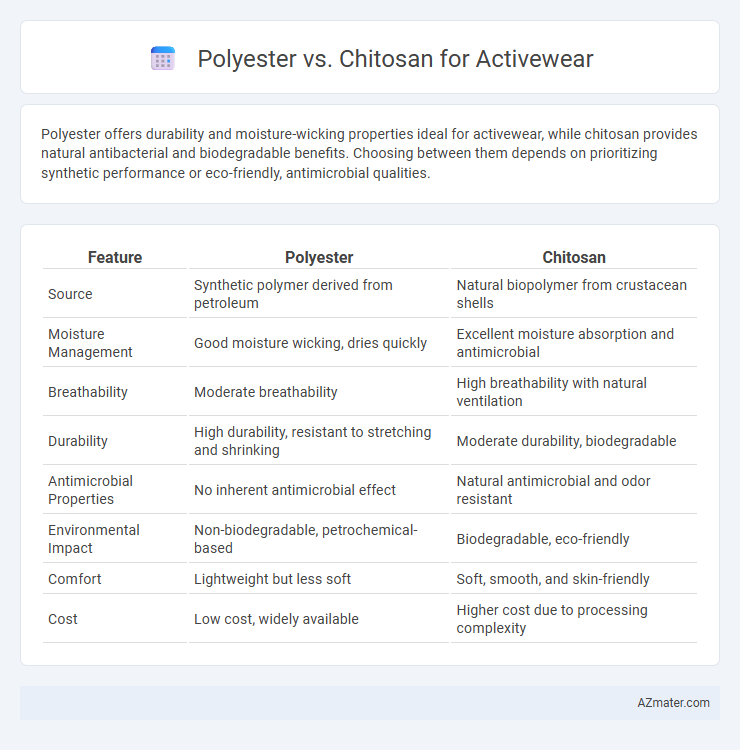Polyester offers durability and moisture-wicking properties ideal for activewear, while chitosan provides natural antibacterial and biodegradable benefits. Choosing between them depends on prioritizing synthetic performance or eco-friendly, antimicrobial qualities.
Table of Comparison
| Feature | Polyester | Chitosan |
|---|---|---|
| Source | Synthetic polymer derived from petroleum | Natural biopolymer from crustacean shells |
| Moisture Management | Good moisture wicking, dries quickly | Excellent moisture absorption and antimicrobial |
| Breathability | Moderate breathability | High breathability with natural ventilation |
| Durability | High durability, resistant to stretching and shrinking | Moderate durability, biodegradable |
| Antimicrobial Properties | No inherent antimicrobial effect | Natural antimicrobial and odor resistant |
| Environmental Impact | Non-biodegradable, petrochemical-based | Biodegradable, eco-friendly |
| Comfort | Lightweight but less soft | Soft, smooth, and skin-friendly |
| Cost | Low cost, widely available | Higher cost due to processing complexity |
Introduction to Activewear Fabrics
Activewear fabrics prioritize moisture-wicking, breathability, and durability to enhance performance and comfort during physical activities. Polyester is widely used for its lightweight, quick-drying properties, and resistance to shrinking and stretching. Chitosan, derived from natural sources, offers antimicrobial and biodegradable benefits, making it an emerging sustainable alternative in the activewear industry.
What is Polyester?
Polyester is a synthetic fiber derived from petroleum-based chemicals, widely used in activewear due to its durability, moisture-wicking properties, and resistance to shrinking and stretching. Engineered to provide lightweight comfort and quick-drying performance, polyester fabrics enhance athletic efficiency by managing sweat and maintaining breathability during intense workouts. Its cost-effectiveness and ease of care have solidified polyester as a popular choice in the textile industry for both casual and high-performance activewear garments.
What is Chitosan?
Chitosan is a natural biopolymer derived from chitin, primarily obtained from the exoskeletons of crustaceans, offering antimicrobial and moisture-wicking properties ideal for activewear. Unlike polyester, a synthetic fiber known for durability and moisture management, chitosan actively inhibits bacterial growth, reducing odor and enhancing fabric breathability. Its biodegradability and skin-friendly characteristics make chitosan a sustainable alternative in performance textiles.
Moisture-Wicking Properties Comparison
Polyester excels in moisture-wicking due to its hydrophobic fibers that quickly draw sweat away from the skin and promote rapid evaporation, making it a preferred choice for activewear designed for intense workouts. Chitosan, derived from chitin in crustacean shells, offers moderate moisture management with natural antibacterial properties but generally lags behind polyester in drying speed and moisture transport efficiency. Advances in textile engineering are enhancing chitosan blends to improve moisture-wicking, yet polyester remains dominant for optimal sweat control in high-performance athletic apparel.
Breathability and Comfort
Polyester activewear offers durability and moisture-wicking properties but tends to trap heat, reducing breathability and sometimes causing discomfort during intense workouts. Chitosan fibers, derived from natural sources, provide superior breathability and antimicrobial benefits, enhancing comfort by allowing better air circulation and reducing odor. Choosing chitosan-based activewear can improve moisture management and skin health, making it ideal for prolonged physical activity in warm conditions.
Odor Control and Antimicrobial Effects
Chitosan fibers exhibit superior antimicrobial properties and odor control compared to polyester, effectively inhibiting bacterial growth that causes unpleasant odors in activewear. Polyester tends to retain odors due to its hydrophobic nature, whereas chitosan's natural biopolymer structure disrupts microbial activity, enhancing freshness during intense physical activities. Incorporating chitosan into activewear fabrics significantly improves hygiene by reducing odor-causing bacteria, making it a preferred choice for performance-enhancing apparel.
Environmental Impact and Sustainability
Polyester, derived from petroleum, has a significant environmental footprint due to its non-biodegradable nature and reliance on fossil fuels, leading to microplastic pollution in water bodies. Chitosan, a biopolymer extracted from crustacean shells, offers superior sustainability with its biodegradability and renewable sourcing, reducing waste and ecological harm. Its antimicrobial properties also enhance activewear performance, making chitosan a greener alternative for eco-conscious textile production.
Durability and Maintenance
Polyester offers exceptional durability due to its resistance to stretching, shrinking, and abrasion, making it ideal for activewear that endures frequent washing. Chitosan, derived from natural sources, provides moderate durability with antimicrobial properties that help reduce odor but requires gentler care to maintain its functional benefits. Maintenance of polyester activewear is straightforward with high tolerance for machine washing and quick drying, whereas chitosan-infused fabrics benefit from mild detergents and lower temperatures to preserve their bioactive features.
Cost and Availability
Polyester dominates the activewear market due to its low cost and widespread availability, making it an economical choice for mass production. Chitosan, derived from crustacean shells, remains more expensive and less accessible, primarily found in niche or high-end activewear markets. The price difference significantly influences manufacturers' decisions, with polyester offering scalability and consistent supply chains compared to the limited and variable sourcing of chitosan.
Which Fabric is Best for Activewear?
Polyester remains a top choice for activewear due to its durability, moisture-wicking properties, and quick-drying capabilities, making it ideal for intense physical activities. Chitosan, derived from shellfish, offers antimicrobial benefits and biodegradability, enhancing odor control and sustainability but lacks the same elasticity and moisture management as polyester. For performance-focused activewear, polyester's blend of resilience and breathability typically outperforms chitosan in maintaining comfort during extended workouts.

Infographic: Polyester vs Chitosan for Activewear
 azmater.com
azmater.com